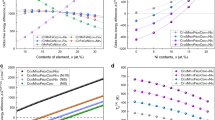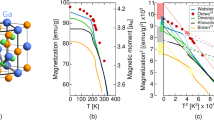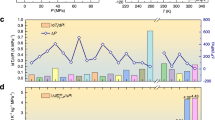Abstract
The search for materials showing large caloric effects close to room temperature has become a challenge in modern materials physics and it is expected that such a class of materials will provide a way to renew present cooling devices that are based on the vapour compression of hazardous gases. Up to now, the most promising materials are giant magnetocaloric materials. The discovery of materials showing a giant magnetocaloric effect at temperatures close to ambient has opened up the possibility of using them for refrigeration1,2,3. As caloric effects refer to the isothermal entropy change achieved by application of an external field, several caloric effects can take place on tuning different external parameters such as pressure and electric field. Indeed the occurrence of large electrocaloric4,5 and elastocaloric6 effects has recently been reported. Here we show that the application of a moderate hydrostatic pressure to a magnetic shape-memory alloy gives rise to a caloric effect with a magnitude that is comparable to the giant magnetocaloric effect reported in this class of materials. We anticipate that similar barocaloric effects will occur in many giant-magnetocaloric materials undergoing magnetostructural transitions involving a volume change.
This is a preview of subscription content, access via your institution
Access options
Subscribe to this journal
Receive 12 print issues and online access
$259.00 per year
only $21.58 per issue
Buy this article
- Purchase on Springer Link
- Instant access to full article PDF
Prices may be subject to local taxes which are calculated during checkout




Similar content being viewed by others
References
Pecharsky, V. K. & Gschneidner, K. A. Jr Giant magnetocaloric effect in Gd5Si2Ge2 . Phys. Rev. Lett. 78, 4494–4497 (1997).
Tegus, O., Brück, E., Buschow, K. H. J. & de Boer, F. R. Transition-metal-based magnetic refrigerants for room-temperature applications. Nature 415, 150–152 (2002).
Krenke, T. et al. Inverse magnetocaloric effect in ferromagnetic Ni–Mn–Sn alloys. Nature Mater. 4, 450–454 (2005).
Mischenko, A. S., Zhang, Q., Scott, J. F., Whatmore, R. W. & Mathur, N. D. Giant electrocaloric effect in thin-film PbZr0.95Ti0.05O3 . Science 311, 1270–1271 (2006).
Neese, B. et al. Large electrocaloric effect in ferroelectric polymers near room temperature. Science 321, 821–823 (2008).
Bonnot, E., Romero, R., Mañosa, L., Vives, E. & Planes, A. Elastocaloric effect associated with the martensitic transition in shape-memory alloys. Phys. Rev. Lett. 100, 125901 (2008).
Müller, K. A. et al. Cooling by adiabatic pressure application in Pr1−xLaxNiO3 . Appl. Phys. Lett. 73, 1056–1058 (1998).
Strässle, Th., Furrer, A., Hossain, Z. & Geibel, Ch. Magnetic cooling by application of external pressure in rare-earth compounds. Phys. Rev. B 67, 054407 (2003).
Gschneidner, K. A., Pecharsky, V. K. & Tsokol, A. O. Recent developments in magnetocaloric materials. Rep. Prog. Phys. 68, 1479–1539 (2005).
Brück, E. Developments in magnetocaloric refrigeration. J. Phys. D 38, R381–R391 (2005).
de Oliveira, N. A. Entropy change upon magnetic field and pressure variations. Appl. Phys. Lett. 90, 052501 (2007).
de Medeiros, L. G., de Oliveira, N. A. & Troper, A. Barocaloric and magnetocaloric effects in La(Fe0.89Si0.11)13 . J. Appl. Phys. 103, 113909 (2008).
Morellon, L. et al. Pressure enhancement of the giant magnetocaloric effect in Tb5Si2Ge2 . Phys. Rev. Lett. 93, 137201 (2004).
Lyubina, J., Nenkov, K., Schultz, L. & Gutfleisch, O. Multiple metamagnetic transitions in the magnetic refrigerant La(Fe,Si)13Hx . Phys. Rev. Lett. 101, 177203 (2008).
Planes, A., Mañosa, L. & Acet, M. Magnetocaloric effect and its relation to shape-memory properties in ferromagnetic Heusler alloys. J. Phys. Condens. Matter 21, 233201 (2009).
Kainuma, R. et al. Magnetic-field-induced shape recovery by reverse phase transformation. Nature 439, 957–960 (2006).
Krenke, T. et al. Magnetic superelasticity and inverse magnetocaloric effect in Ni–Mn–In. Phys. Rev. B 75, 104414 (2007).
Sharma, V. K., Chattopadhyat, M. K., Shaeb, K. H. B., Chouhan, A. & Roy, S. B. Large magnetoresistance in Ni50Mn34In16 alloy. Appl. Phys. Lett. 89, 222509 (2006).
Mañosa, L. et al. Effects of hydrostatic pressure on the magnetism and martensitic transition of Ni–Mn–In magnetic superelastic alloys. Appl. Phys. Lett. 92, 012515 (2008).
Pecharsky, V. K. & Gschneidner, K. A. Jr. in Magnetism and Structure in Functional Materials (eds Planes, A., Mañosa, L. & Saxena, A.) 199–222 (Springer Series in Materials Science, 2005).
Aksoy, S., Acet, M., Deen, P. P., Mañosa, L. & Planes, A. Magnetic correlations in martensitic Ni–Mn-based Heusler shape-memory alloys: Neutron polarization analysis. Phys. Rev. B 79, 212401 (2009).
Casanova, F. et al. Direct observation of the magnetic-field-induced entropy change in Gd5(SixGe1−x)4 giant magnetocaloric alloys. Appl. Phys. Lett. 86, 262504 (2005).
Mañosa, L., Planes, A. & Moya, X. Comment on ‘The magnetocaloric effect of LaFe11.6Si1.4, La0.8Nd0.2Fe11.5Si1.5, and Ni43Mn46Sn11 compounds in the vicinity of the first-order phase transition’. Adv. Mater. 21, 3725–3726 (2009).
Planes, A. & Mañosa, L. Vibrational properties of shape memory alloys. Solid State Phys. 55, 159–267 (2001).
Krenke, T. PhD thesis, Univ. Duisburg-Essen (2007).
Wurflinger, A. Differential thermal-analysis under high-pressure. 4. Low-temperature DTA of solid–solid and solid–liquid transitions of several hydrocarbons up to 3 kbar. Ber. Bunsen Gesell. Phys. Chem. Chem. Phys. 79, 1195–1201 (1975).
Marcos, J. et al. A high-sensitivity differential scanning calorimeter with magnetic field for magnetostructural transitions. Rev. Sci. Inst. 74, 4768–4771 (2003).
Tolédano, J. C. & Tolédano, P. The Landau Theory of Phase Transitions (World Scientific, 1987).
Sasioglu, E., Sandratskii, L. M. & Bruno, P. Role of conduction electrons in mediating exchange interactions in Mn-based Heusler alloys. Phys. Rev. B 77, 064417 (2008).
Buchelnikov, V. D. et al. Monte Carlo study of the influence of antiferromagnetic exchange interactions on the phase transitions of ferromagnetic Ni-Mn-X alloys (X=In,Sn,Sb). Phys. Rev. B 78, 184427 (2008).
Acknowledgements
This work was supported by CICyT (Spain), projects MAT2007-62100, and FIS2008-00837 and by Deutsche Forschungsgemeinschaft, grant No. SPP 1239. D.G. acknowledges support from DGICyT (Spain).
Author information
Authors and Affiliations
Contributions
L.M. and A.P. planned the experiments in collaboration with J.T. and M.A. Sample preparation and magnetization measurements were carried out by S.A. and M.A. Calorimetric measurements under pressure were carried out by E.B. and M.B., and under magnetic field, by D.G. All authors discussed the results and analysed the data. The manuscript was prepared by L.M. in collaboration with A.P., J.T. and M.A.
Corresponding author
Ethics declarations
Competing interests
The authors declare no competing financial interests.
Rights and permissions
About this article
Cite this article
Mañosa, L., González-Alonso, D., Planes, A. et al. Giant solid-state barocaloric effect in the Ni–Mn–In magnetic shape-memory alloy. Nature Mater 9, 478–481 (2010). https://doi.org/10.1038/nmat2731
Received:
Accepted:
Published:
Issue Date:
DOI: https://doi.org/10.1038/nmat2731
This article is cited by
-
Prediction and understanding of barocaloric effects in orientationally disordered materials from molecular dynamics simulations
npj Computational Materials (2024)
-
Plastic Crystal Neopentyl Glycol/Multiwall Carbon Nanotubes Composites for Highly Efficient Barocaloric Refrigeration System
Journal of Thermal Science (2024)
-
Magnetically retrievable nanocatalyst Fe3O4@CPTMO@dithizone-Ni for the fabrication of 4H-benzo[h]chromenes under green medium
Scientific Reports (2023)
-
Thermodynamic Analysis on the Performance of Barocaloric Refrigeration Systems Using Neopentyl Glycol as the Refrigerant
Journal of Thermal Science (2023)
-
Barocaloric Material with High Thermal Conductivity for Room-Temperature Refrigeration
Journal of Thermal Science (2023)



